The Cornell Lab Bird Academy › Discussion Groups › Nature Journaling and Field Sketching › Jump Right in!
-
 I like the stability and clarity of the photo, though I'd rather be outside with this little guy. I noticed colors and feather shapes I would not have without drawing it. I'm definitely here to draw and not take photos-- though I'll keep doing that, too!
I like the stability and clarity of the photo, though I'd rather be outside with this little guy. I noticed colors and feather shapes I would not have without drawing it. I'm definitely here to draw and not take photos-- though I'll keep doing that, too! -
 I noticed things that I never had about Yellow Warblers, particularly how much black is in the wing. I tried not to do a lot of erasing, but I obviously need to!
I noticed things that I never had about Yellow Warblers, particularly how much black is in the wing. I tried not to do a lot of erasing, but I obviously need to! -
This was a fun assignment! I haven't used watercolors since high school art, and let's just say that was more than a few years ago. Nothing really came easily for me - I had to work for every stroke and every color. I haven't drawn a bird to this detail before, and over the years I've preferred writing to drawing, so this is a good stretch for me. I did this drawing twice, once with just pencil and then again with pencil, watercolors and marker. I was really intrigued by the feet holding on to the branch, and interestingly I did a much better job with them in the first pencil drawing. I might not have had the time to appreciate the feet holding the branch if I was trying to quickly capture this bird in the field.

-
It was pretty easy. I've been drawing for quite a while using photos and other drawings as a reference point. The overall shape was fine but the beak and the correct angle on the head was kind of hard for me. I probably wouldn't have noticed the turns and curves of the branch and would have tended to make it more streamlined. This would make drawing from nature look not quite as realistic so yes, I have to work on that!

-
The joy of having a photo is being able to take time looking, colour matching, getting as much detail down as possible. It was only after finishing that I realized I had missed the upper part of the wing, so when I paint this again, I will hopefully remember! It was nice to try out watercolours and the water-reservoir brush; I can appreciate how handing this little kit is for taking out in the field. I might not have noticed the brown striations or streaks on the belly and how that brown carries on up to just under the beak on the throat if I hadn't been asked to draw it. Those sorts of details would definitely make a difference when nature journaling.
-
Drawing from the photo is good for me, as a beginner, because I have so much time to look and capture everything I watn to. I feel challenged by the proportions of the bird, I think is one of the most difficult things to do, I had to re-do the bill several times. Drawing from a photo makes me focus more on the details, I think is a great way lo learn more about birds.

-
1. I am a beginner and super detail-oriented. Drawing from a photo helps me to see details I would miss if the bird was moving outdoors. On the website there is a game to test your knowledge of bird anatomy. I found that my brief exploration improved drawing the bird in proper proportion, relatively speaking. I wish I knew how to better illustrate the fluffy/downy feathers from say, tail feathers.

-
I love how you captured the eye in greater detail, and the streaks on the breast of the bird!
-
-
 Drawing from the photo felt easier than trying to sketch a bird in the field. There is the luxury of everything sitting still. Using colour - in this case watercolour - is new to me, so I find it challenging and I hope to improve this. I want to learn how to use the colours for reference without losing details that my pencil and pen create. I might have overlooked the feather groupings and the colour of the legs as well as the shape of the leaves if I had not stopped to draw it.
-Laurna, Toronto Canada
Drawing from the photo felt easier than trying to sketch a bird in the field. There is the luxury of everything sitting still. Using colour - in this case watercolour - is new to me, so I find it challenging and I hope to improve this. I want to learn how to use the colours for reference without losing details that my pencil and pen create. I might have overlooked the feather groupings and the colour of the legs as well as the shape of the leaves if I had not stopped to draw it.
-Laurna, Toronto Canada -
Love your drawling.
-
Well done! I love how you added text about the bird. Great job on the watercolor! I’m new to it too.
-
-
Comfortable. I have done drawings before and pencil is my favorite. Pretty much all of it was pretty easy. I took the course to learn some new things I hope. I do birding with friends for some years now. Drawing will help me remember them better. The bird likes berries so my guess is that it is in a berry type bush or a birch tree of some sort by the leaves. Paper makes a big difference in what you want to do. Nature is one of my favorite things to watch. I learned that the color of beaks and legs also help identify the bird in some cases.

-
Getting the dimensions/proportions and details were challenging. But taking note of the warbler's position in relation to the leaves and the branches helped a lot. Through a photo, I noticed more of the details and the richness of the colors that I likely wouldn't have picked up from a drawing. I suspect I'll need to take photos first when I begin field sketching. My eyesight is not great and I feel like I'd miss a lot of the birds' details along with their environment.

-
 Drawing really made me look at the details. It imprinted them in a way that the photograph did not. The drawing tests my patience. The photo is instant gratification.
Drawing really made me look at the details. It imprinted them in a way that the photograph did not. The drawing tests my patience. The photo is instant gratification. -
The advantages of the photos over the drawings and vice versa? The photograph has great detail and color information that a drawing done on a smaller format using only graphite lacks. Nevertheless it makes the subject look flat. Although the photograph is focused on the bird a draftsperson has more control over which part of the picture he can add detail to as well as what to omit.
 1. I felt comfortable drawing from the photograph because the subject wasn’t moving. Getting the proportions and the main pose of the bird was easy, however it was difficult to capture all the detail that I saw in the photograph. I think I should have drawn the bird at least twice as big. Also it was a challenge to capture the brightness of the bird's feathers. I think I would have been more comfortable had I been working on toned paper or if I had added a tone to the entire background (the photograph background is a medium tone and green in contrast to the yellow of the bird so that it really stands out).
2. Drawing from this photograph made me observe each part of the bird for a longer period of time than I would have just casually looking at it. This allowed me to notice the detail of the feathers around the eyes, the subtle color difference between the birds above and below feathers and the peculiar shape of the top part of the beak. I think that observing the subject for longer periods of time certainly makes a difference and it would do so in nature journaling as well.
1. I felt comfortable drawing from the photograph because the subject wasn’t moving. Getting the proportions and the main pose of the bird was easy, however it was difficult to capture all the detail that I saw in the photograph. I think I should have drawn the bird at least twice as big. Also it was a challenge to capture the brightness of the bird's feathers. I think I would have been more comfortable had I been working on toned paper or if I had added a tone to the entire background (the photograph background is a medium tone and green in contrast to the yellow of the bird so that it really stands out).
2. Drawing from this photograph made me observe each part of the bird for a longer period of time than I would have just casually looking at it. This allowed me to notice the detail of the feathers around the eyes, the subtle color difference between the birds above and below feathers and the peculiar shape of the top part of the beak. I think that observing the subject for longer periods of time certainly makes a difference and it would do so in nature journaling as well. -
Magnificent sketch! I love how you did the shading, and the added field marks.
-
Beautiful!
-
-
1) A bit nervous, but tried tom look closely and draw what I see. Once I looked at how the bird is located on the branch and how the different body parts are in relation to each other it was a bit easier to get the dimensions. Found it difficult to get the lichen and the shading on the leaves. 2) Probably wouldn't have noticed the fringed feathers, and the different shadings - just see more of the whole and register that without looking specifically at each part. Yes I think it is easy to just register the image rather than looking at how all the subparts of the image are in relation to each other and how they overlap - it is more likely that a phot is seen as one or two dimensional.
-
This was interesting. I have always been intimidated about drawing birds. I realize now that careful observations will help me improve. I did love having a subject that didn't jump around. I will need to improve my computer skills, however. Taking the photo was the most challenging part.

-
This was a very fun exercise. I'm new to drawing so the most difficult aspects of this are getting the proportions right as well as learning how to show shadows and negative space. But I'm overall pleased with this drawing. I'm impressed at how some people can whip their drawings together in just a few minutes! This took me over an hour. It's so easy to get lost in time when drawing.

-
I enjoyed drawing from the photo. However, I've always been better at drawing inanimate objects. :) I want to get more life into my drawings, eyes are my nemesis. I believe that becoming intimate with your subject always draws your attention to the finer details. I've included my lowly attempt. :)

-
I'm so used to my subjects moving so fast when I am sketching birds. It was nice to draw from a photo! I feel like I may have made it more wooden feeling, though, because there was no movement to capture. But I was able to see details I wouldn't otherwise have been able to see. The stripes on the bird's breast I probably wouldn't have seen if it were in real life. I did a very quick sketch, in ink, because that's how I usually sketch when I am nature journaling. The hardest part for me was judging my work. I am not very talented or good at drawing.

-
Loved the exercise. The photo made it easy to observe, sketch, observe, sketch, observe some more and sketched and then try to get the main colours right. In nature the little fellow would have been long gone before I even finished typing these three sentences. The annotations made me think more about the details as well, notably the difference between the finer dark grey stripping on wings compared to orangish brown coarse stripping on lower body. Tried to complete my sketch in under 5 minutes since figured that would be well in excess of what a real nature venue would allow. Will have to try water colour paints... the colouring pencils were not capturing the shades or hues very well. Great sketches by all the other participants... congratulations to everyone. Not ready to share my attempt yet, my grandkids may see them and may be merciless in their critique.
-
 It's a little bit hard to depict the feather of this bird but I think the part of general outline is OK. There are much more layers of birds' feather on their wings and that's a difficulty for me to draw them.
It's a little bit hard to depict the feather of this bird but I think the part of general outline is OK. There are much more layers of birds' feather on their wings and that's a difficulty for me to draw them. -
A little intimidating. More comfortable starting with the branches. A bit of a struggle to get the bird’s ratio and perspective correct. The fine feathering structure was more varied than I realized and fell there will be a rather larger learning curve to get it accurately.

-
 I enjoyed this… it was a good feeling to “jump in.” It helped to format my drawing area to approximate the dimensions of the image on my iPad screen. Then, blocking in the branches provided a foundation for me to have some success with my goal of placing the warbler in relative size with its surroundings. Drawing from a photo is great! Everything is locked in place. Drawing most definitely inspired me to look closely at details and their relationships with each other. I am an amateur photo-naturalist and believe this skill (photo to drawing) will greatly enhance my observation skills and understanding of Nature’s intricacies. It seemed logical to begin labeling and jotting down questions.
I enjoyed this… it was a good feeling to “jump in.” It helped to format my drawing area to approximate the dimensions of the image on my iPad screen. Then, blocking in the branches provided a foundation for me to have some success with my goal of placing the warbler in relative size with its surroundings. Drawing from a photo is great! Everything is locked in place. Drawing most definitely inspired me to look closely at details and their relationships with each other. I am an amateur photo-naturalist and believe this skill (photo to drawing) will greatly enhance my observation skills and understanding of Nature’s intricacies. It seemed logical to begin labeling and jotting down questions. -
Well done! This is one of my favorites!
-
-
I’m so rusty with drawing that I felt a little intimidated. 1. I feel like my proportions are off with the bird. It will be interesting to see if there are improvements over the course of time. Drawing from a photo is a bit easier for things like birds and animals since they are captured in the moment, and for seeing some detail. The challenge is the lighting made it a little difficult to see the detail of leaves on the tree, but I also just roughed those in. 2. I probably wouldn’t have noticed the nuanced coloring on the head and wings. 3. Making notations of those differences and nuances might trigger my memory when doing field sketches.

-
My first pencildrawing of the yellow bird. I am going to color it with colorpencils. Can't decide wether to go over it with a black pen first. I know that will give the drawing a harder impression than if I dont. And I dont nessecarily want that. On the other hand I will be more in control of the drawing. /Eva

-
Ready for colors. But was it destroyed in the proces? Hmm

-
@Eva <p style="text-align: left;">Now with colors 🙂</p>

-
-
Trying to the get proportions on the beak just right really made me look at the shape of the beak. A detail I wouldn't have thought about while taking a photo. Drawing lets me pick what stands out to me.
-
 Liz didn’t say to paint, only to draw — so that’s exactly what I did. I worked quickly and tried to capture some dimension in B&W.
1. I loved drawing from the photo … it helped see details & proportions more easily.
The feathers individually were challenging - so I just blocked them in - and the basic shape was fairly easy.
2. The little circle around the eye is never seen unless I draw a bird. The nuanced feathers and markings would not be noticed in detail except for drawing. The beak is very different when drawing from photos than seeing on the wing. All those details would slow me down and possibly cause me to ask WHY/purpose (form follows function) questions in my journal.
Liz didn’t say to paint, only to draw — so that’s exactly what I did. I worked quickly and tried to capture some dimension in B&W.
1. I loved drawing from the photo … it helped see details & proportions more easily.
The feathers individually were challenging - so I just blocked them in - and the basic shape was fairly easy.
2. The little circle around the eye is never seen unless I draw a bird. The nuanced feathers and markings would not be noticed in detail except for drawing. The beak is very different when drawing from photos than seeing on the wing. All those details would slow me down and possibly cause me to ask WHY/purpose (form follows function) questions in my journal. -
 Sketched proportions of bird aren’t exactly right & still need fine tuning.
The 3D quality needs work through shading. Too flat looking.
Overall, the bird does feel cohesive though — like it could actually fly. But the bird needs much tweaking and refinement for accuracy.
Ready for next learning steps…
Sketched proportions of bird aren’t exactly right & still need fine tuning.
The 3D quality needs work through shading. Too flat looking.
Overall, the bird does feel cohesive though — like it could actually fly. But the bird needs much tweaking and refinement for accuracy.
Ready for next learning steps…
-
Read More:
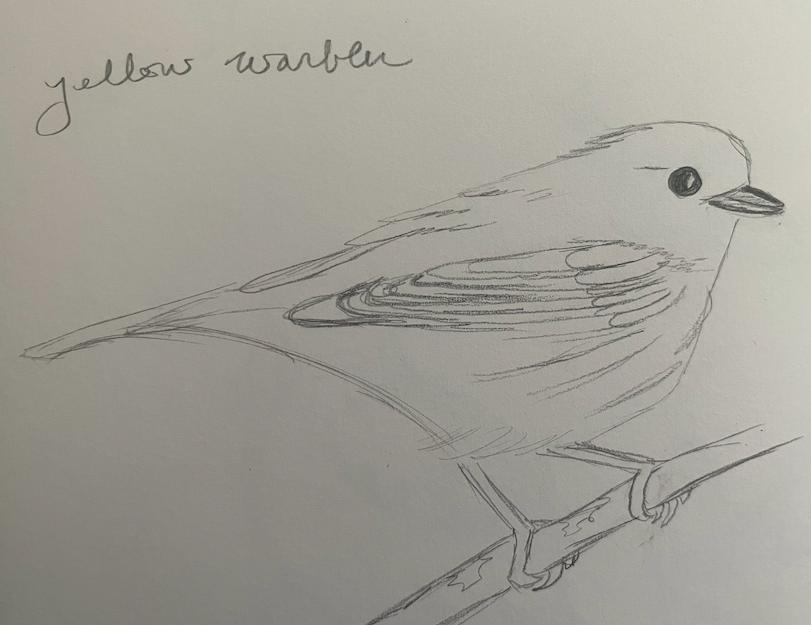 I like the stability and clarity of the photo, though I'd rather be outside with this little guy. I noticed colors and feather shapes I would not have without drawing it. I'm definitely here to draw and not take photos-- though I'll keep doing that, too!
I like the stability and clarity of the photo, though I'd rather be outside with this little guy. I noticed colors and feather shapes I would not have without drawing it. I'm definitely here to draw and not take photos-- though I'll keep doing that, too!  I noticed things that I never had about Yellow Warblers, particularly how much black is in the wing. I tried not to do a lot of erasing, but I obviously need to!
I noticed things that I never had about Yellow Warblers, particularly how much black is in the wing. I tried not to do a lot of erasing, but I obviously need to! 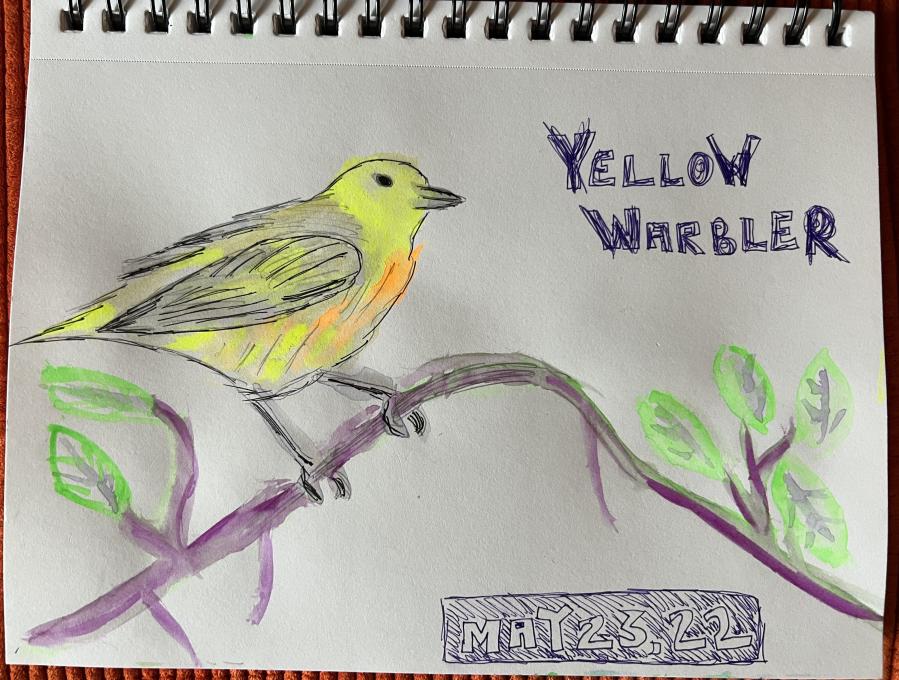
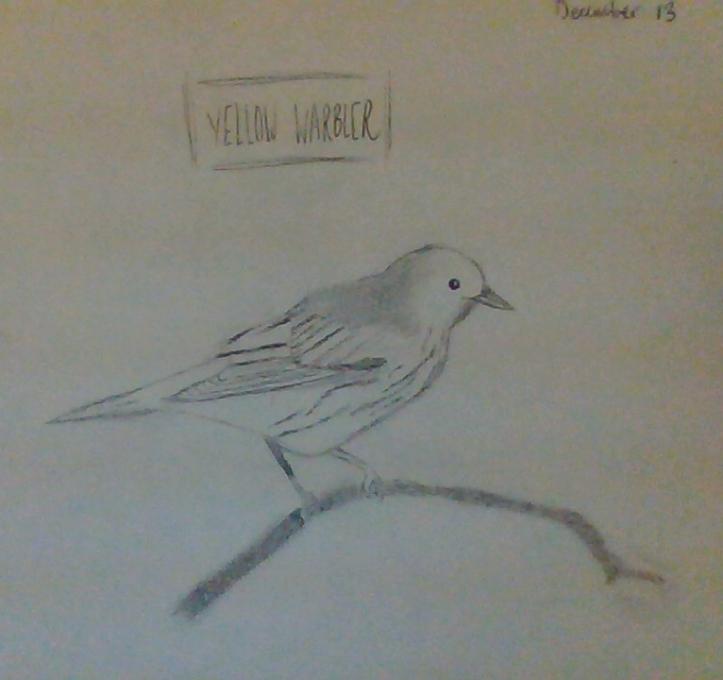
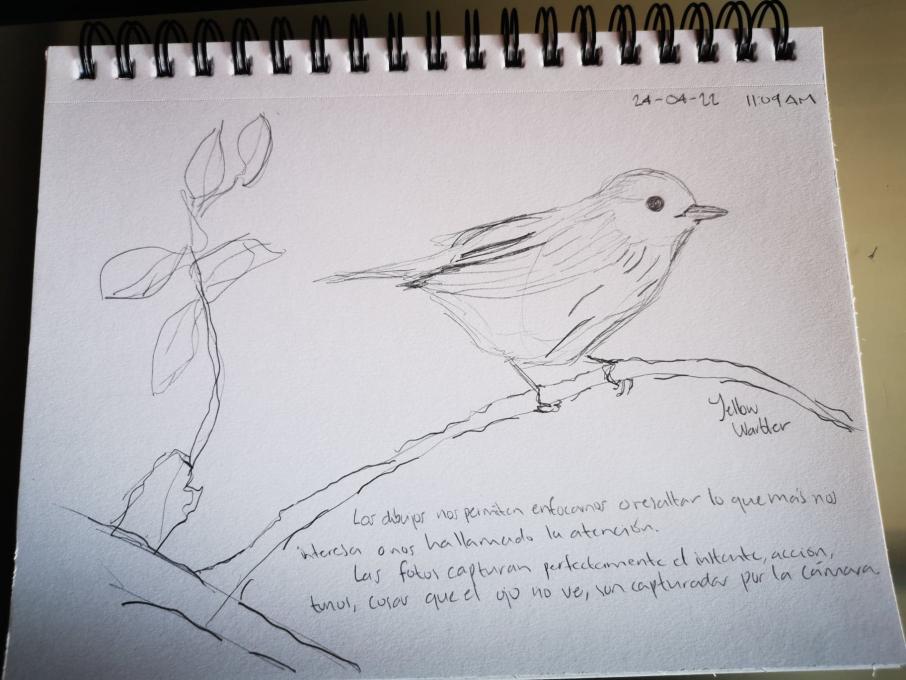
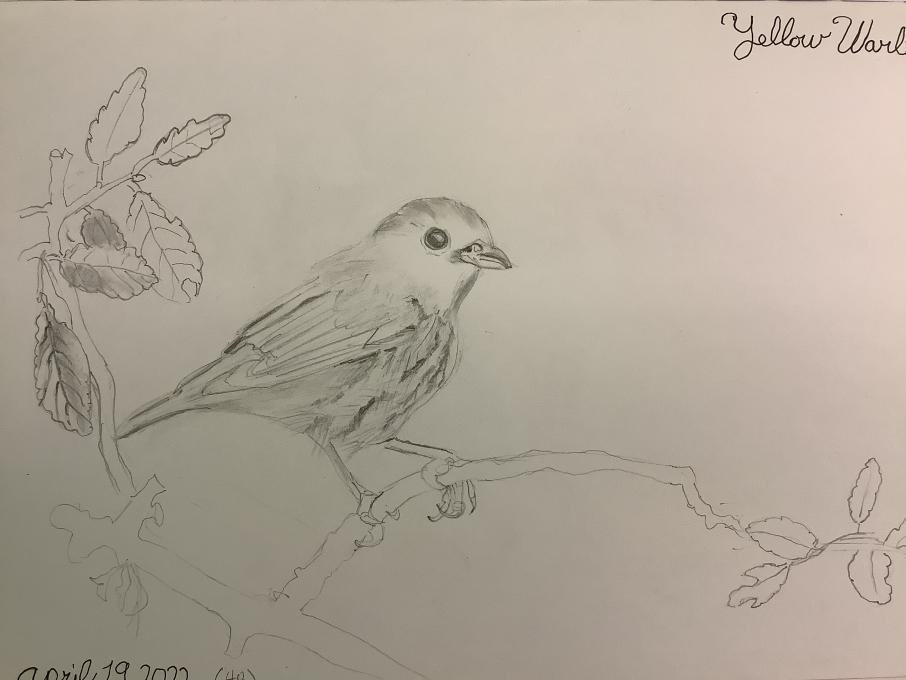
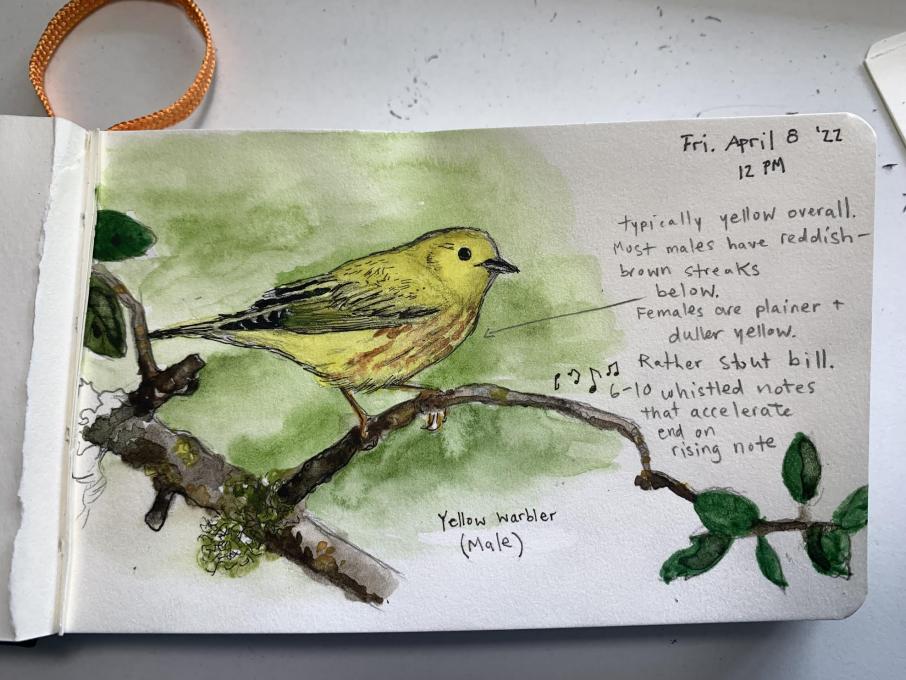 Drawing from the photo felt easier than trying to sketch a bird in the field. There is the luxury of everything sitting still. Using colour - in this case watercolour - is new to me, so I find it challenging and I hope to improve this. I want to learn how to use the colours for reference without losing details that my pencil and pen create. I might have overlooked the feather groupings and the colour of the legs as well as the shape of the leaves if I had not stopped to draw it.
-Laurna, Toronto Canada
Drawing from the photo felt easier than trying to sketch a bird in the field. There is the luxury of everything sitting still. Using colour - in this case watercolour - is new to me, so I find it challenging and I hope to improve this. I want to learn how to use the colours for reference without losing details that my pencil and pen create. I might have overlooked the feather groupings and the colour of the legs as well as the shape of the leaves if I had not stopped to draw it.
-Laurna, Toronto Canada 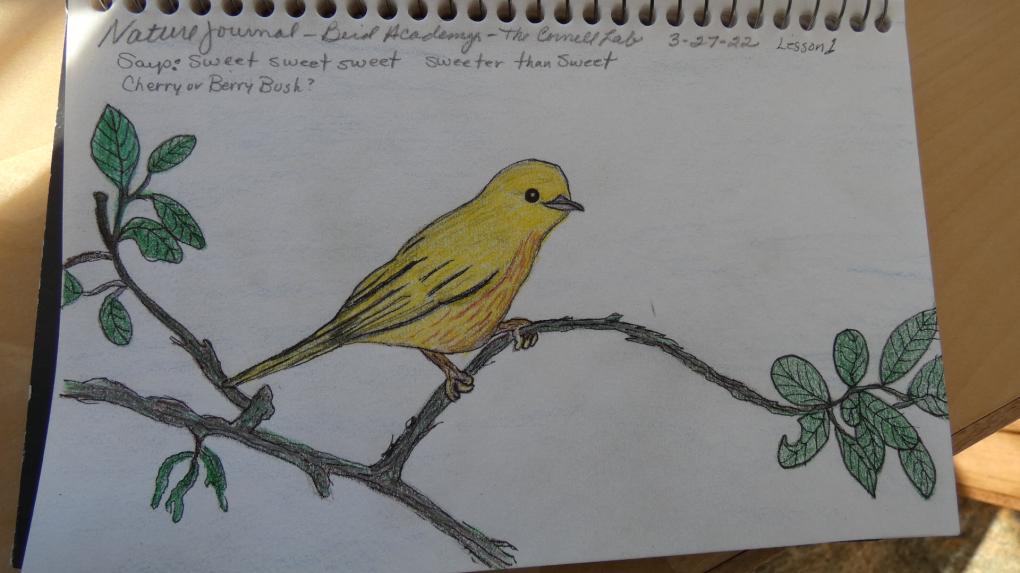
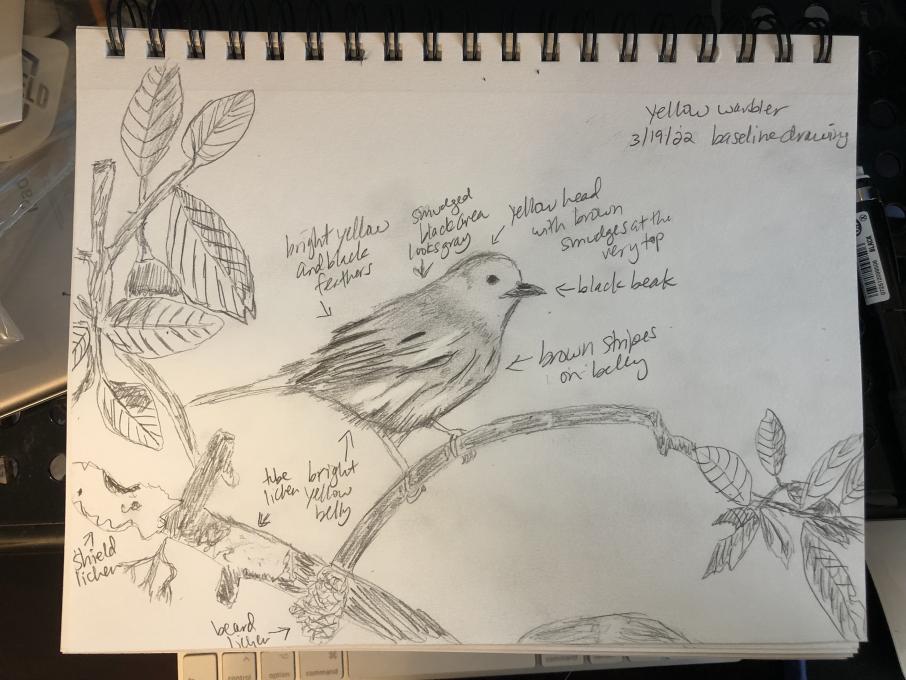
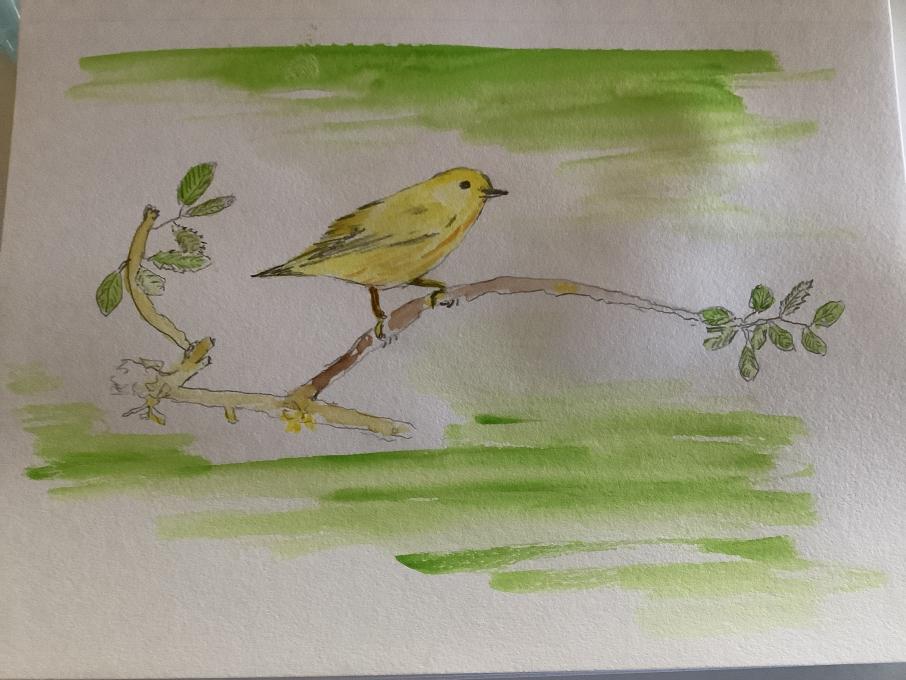 Drawing really made me look at the details. It imprinted them in a way that the photograph did not. The drawing tests my patience. The photo is instant gratification.
Drawing really made me look at the details. It imprinted them in a way that the photograph did not. The drawing tests my patience. The photo is instant gratification. 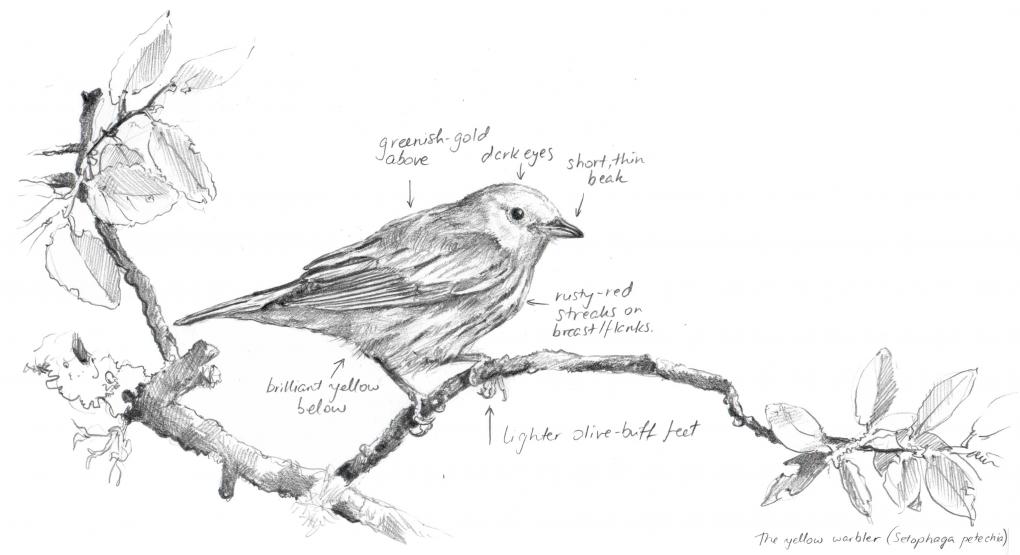 1. I felt comfortable drawing from the photograph because the subject wasn’t moving. Getting the proportions and the main pose of the bird was easy, however it was difficult to capture all the detail that I saw in the photograph. I think I should have drawn the bird at least twice as big. Also it was a challenge to capture the brightness of the bird's feathers. I think I would have been more comfortable had I been working on toned paper or if I had added a tone to the entire background (the photograph background is a medium tone and green in contrast to the yellow of the bird so that it really stands out).
2. Drawing from this photograph made me observe each part of the bird for a longer period of time than I would have just casually looking at it. This allowed me to notice the detail of the feathers around the eyes, the subtle color difference between the birds above and below feathers and the peculiar shape of the top part of the beak. I think that observing the subject for longer periods of time certainly makes a difference and it would do so in nature journaling as well.
1. I felt comfortable drawing from the photograph because the subject wasn’t moving. Getting the proportions and the main pose of the bird was easy, however it was difficult to capture all the detail that I saw in the photograph. I think I should have drawn the bird at least twice as big. Also it was a challenge to capture the brightness of the bird's feathers. I think I would have been more comfortable had I been working on toned paper or if I had added a tone to the entire background (the photograph background is a medium tone and green in contrast to the yellow of the bird so that it really stands out).
2. Drawing from this photograph made me observe each part of the bird for a longer period of time than I would have just casually looking at it. This allowed me to notice the detail of the feathers around the eyes, the subtle color difference between the birds above and below feathers and the peculiar shape of the top part of the beak. I think that observing the subject for longer periods of time certainly makes a difference and it would do so in nature journaling as well. 

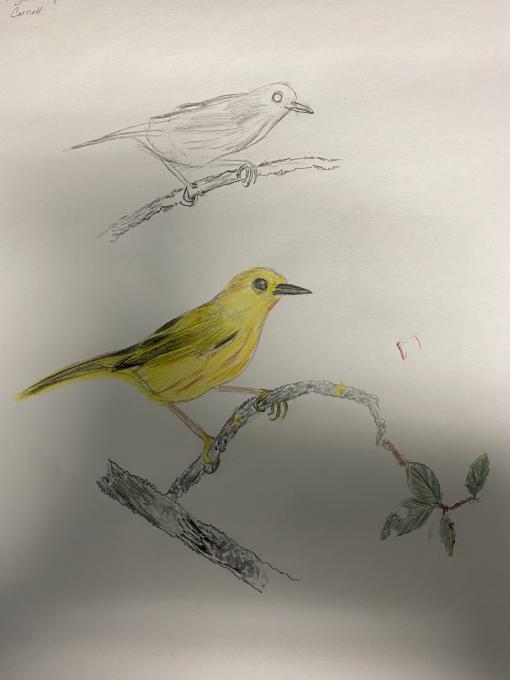

 It's a little bit hard to depict the feather of this bird but I think the part of general outline is OK. There are much more layers of birds' feather on their wings and that's a difficulty for me to draw them.
It's a little bit hard to depict the feather of this bird but I think the part of general outline is OK. There are much more layers of birds' feather on their wings and that's a difficulty for me to draw them. 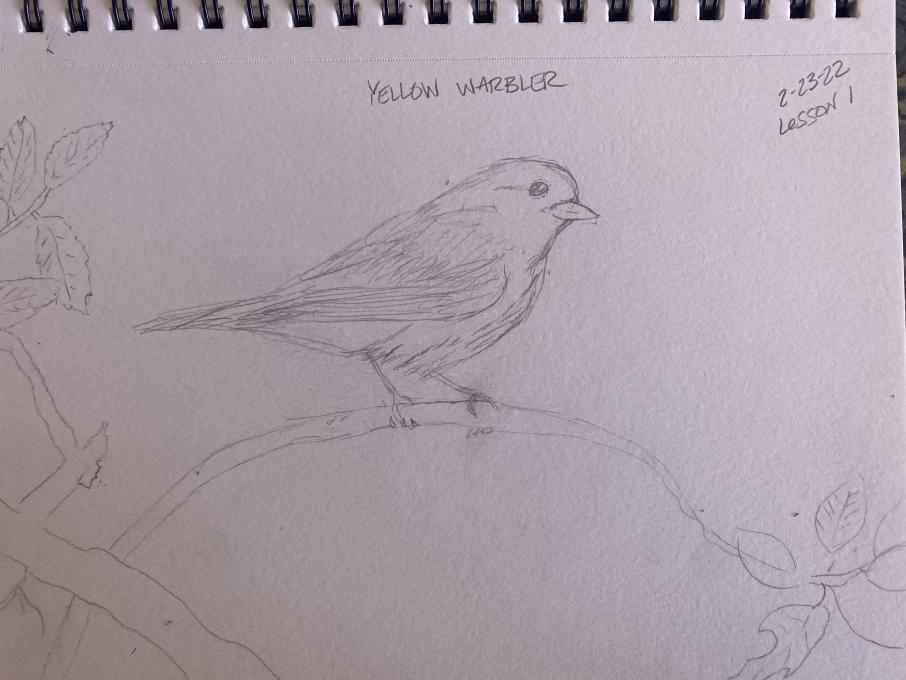
 I enjoyed this… it was a good feeling to “jump in.” It helped to format my drawing area to approximate the dimensions of the image on my iPad screen. Then, blocking in the branches provided a foundation for me to have some success with my goal of placing the warbler in relative size with its surroundings. Drawing from a photo is great! Everything is locked in place. Drawing most definitely inspired me to look closely at details and their relationships with each other. I am an amateur photo-naturalist and believe this skill (photo to drawing) will greatly enhance my observation skills and understanding of Nature’s intricacies. It seemed logical to begin labeling and jotting down questions.
I enjoyed this… it was a good feeling to “jump in.” It helped to format my drawing area to approximate the dimensions of the image on my iPad screen. Then, blocking in the branches provided a foundation for me to have some success with my goal of placing the warbler in relative size with its surroundings. Drawing from a photo is great! Everything is locked in place. Drawing most definitely inspired me to look closely at details and their relationships with each other. I am an amateur photo-naturalist and believe this skill (photo to drawing) will greatly enhance my observation skills and understanding of Nature’s intricacies. It seemed logical to begin labeling and jotting down questions. 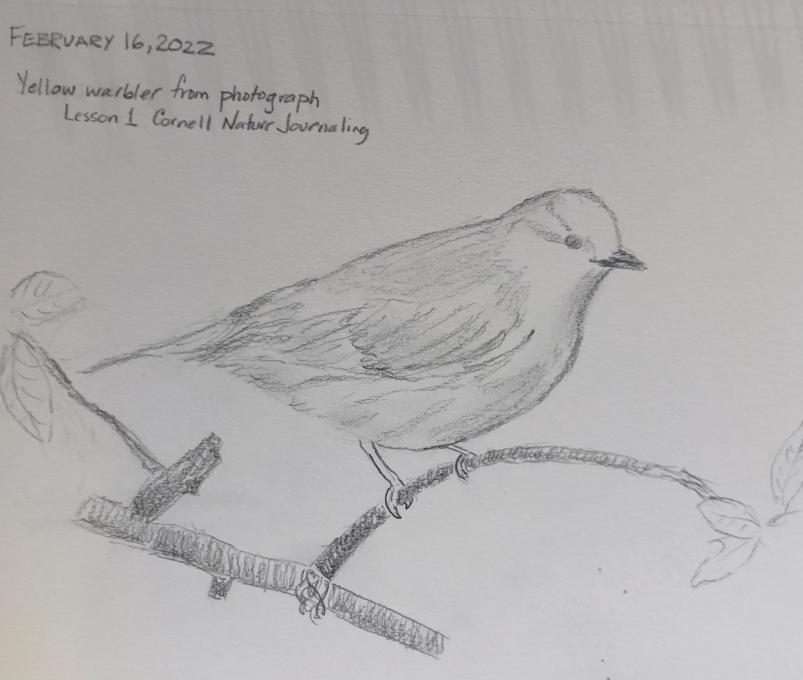

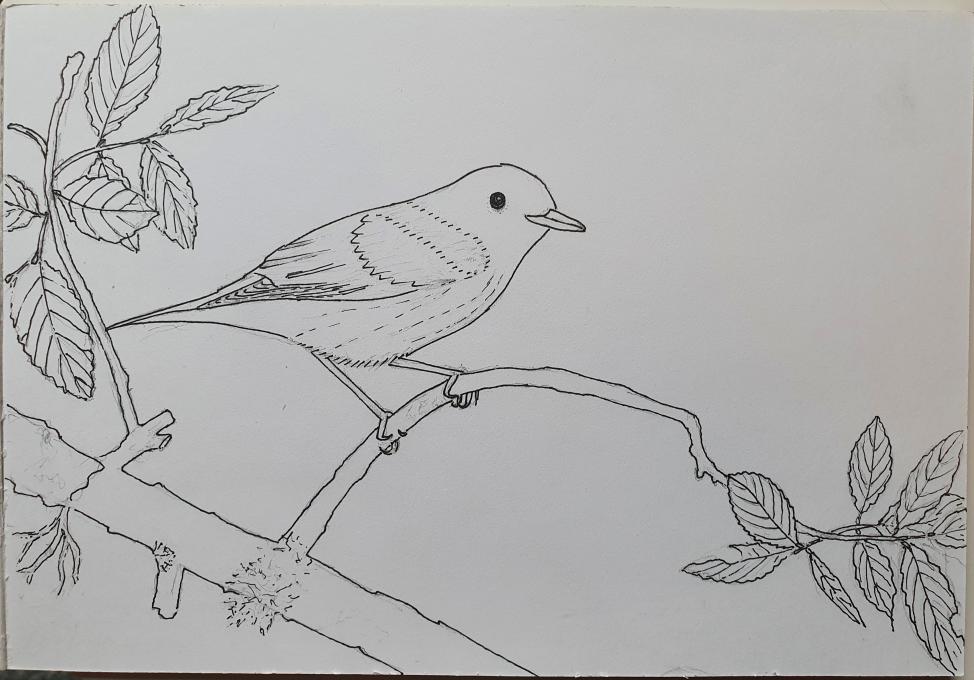

 Liz didn’t say to paint, only to draw — so that’s exactly what I did. I worked quickly and tried to capture some dimension in B&W.
1. I loved drawing from the photo … it helped see details & proportions more easily.
The feathers individually were challenging - so I just blocked them in - and the basic shape was fairly easy.
2. The little circle around the eye is never seen unless I draw a bird. The nuanced feathers and markings would not be noticed in detail except for drawing. The beak is very different when drawing from photos than seeing on the wing. All those details would slow me down and possibly cause me to ask WHY/purpose (form follows function) questions in my journal.
Liz didn’t say to paint, only to draw — so that’s exactly what I did. I worked quickly and tried to capture some dimension in B&W.
1. I loved drawing from the photo … it helped see details & proportions more easily.
The feathers individually were challenging - so I just blocked them in - and the basic shape was fairly easy.
2. The little circle around the eye is never seen unless I draw a bird. The nuanced feathers and markings would not be noticed in detail except for drawing. The beak is very different when drawing from photos than seeing on the wing. All those details would slow me down and possibly cause me to ask WHY/purpose (form follows function) questions in my journal. 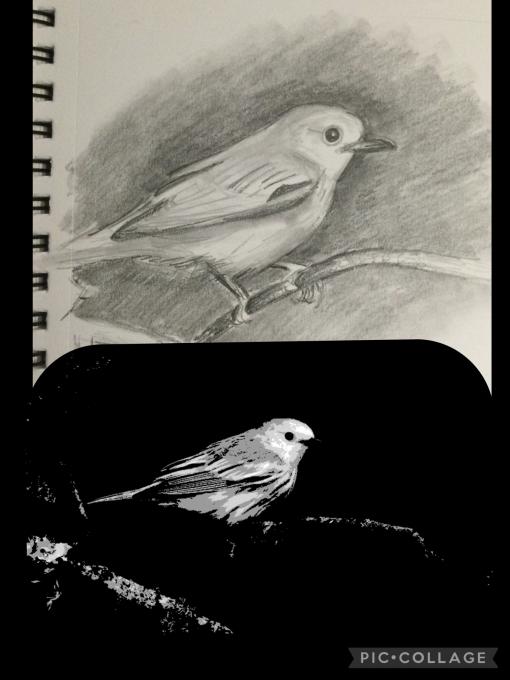 Sketched proportions of bird aren’t exactly right & still need fine tuning.
The 3D quality needs work through shading. Too flat looking.
Overall, the bird does feel cohesive though — like it could actually fly. But the bird needs much tweaking and refinement for accuracy.
Ready for next learning steps…
Sketched proportions of bird aren’t exactly right & still need fine tuning.
The 3D quality needs work through shading. Too flat looking.
Overall, the bird does feel cohesive though — like it could actually fly. But the bird needs much tweaking and refinement for accuracy.
Ready for next learning steps…